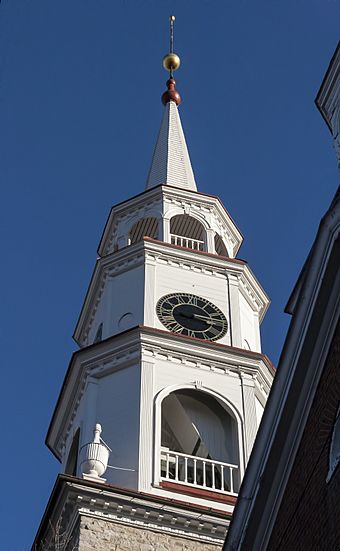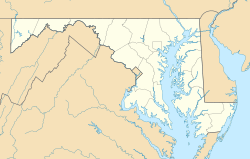Frederick Historic District facts for kids
Quick facts for kids |
|
|
Frederick Historic District
|
|

Trinity Chapel, West Church Street
|
|
| Location | 2 blocks E and 3 blocks W of Market St., from South St. to 7th St., Frederick, Maryland |
|---|---|
| Area | 265 acres (107 ha) |
| Built | 1800 |
| Architectural style | Greek Revival, Italianate, Federal |
| NRHP reference No. | 73000916 |
| Added to NRHP | October 18, 1973 |
|
Frederick Historic District (Boundary Increase)
|
|
| Lua error in Module:Location_map at line 420: attempt to index field 'wikibase' (a nil value). | |
| Location | Roughly bounded by Thirteenth, East and Wisner, South and Madison Sts., W. College Terr. and Rosemont and Trail Aves., Frederick, Maryland |
|---|---|
| Area | 825 acres (334 ha) |
| Architect | Multiple |
| Architectural style | Greek Revival, Late Victorian, Federal |
| NRHP reference No. | 88000713 |
| Added to NRHP | June 13, 1988 |
The Frederick Historic District is a special area in Frederick, Maryland. It's like a big outdoor museum! This district is recognized as a historic district because it has many old and important buildings.
These buildings show how people lived and worked from the late 1700s up to 1941. You can find all sorts of structures here, including homes, shops, churches, and even old factories.
Contents
What is a Historic District?
A historic district is a group of buildings, structures, or sites that are important because of their history or architecture. They are often protected to keep their special character. The Frederick Historic District is listed on the National Register of Historic Places. This means it's officially recognized by the United States government as a place worth preserving.
Why is Frederick's District Special?
The Frederick Historic District covers a large part of the city's old center. It's a great place to see different types of architecture. You can spot homes built in the Queen Anne style, which often have towers and decorative details. There are also American Foursquare homes, which are usually square-shaped and practical.
Architectural Styles to Look For
Many churches in the district show off grand architectural styles. You might see buildings inspired by ancient Greek temples, known as Greek Revival. Others might look like old European castles, built in the Richardsonian Romanesque style. Some buildings even use the Colonial Revival style, which brings back designs from America's early days.
On the east side of the district, you'll find older industrial buildings. These were once busy factories or workshops. They tell the story of how Frederick grew and changed over time.
History of the District
The Frederick Historic District was first added to the National Register of Historic Places in 1973. This was a big step to protect its unique heritage. Later, in 1988, the district was made even larger to include more historic areas. This expansion helped to preserve even more of Frederick's important past.



